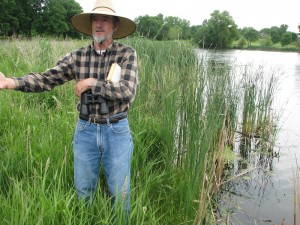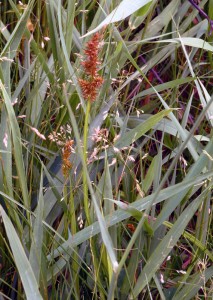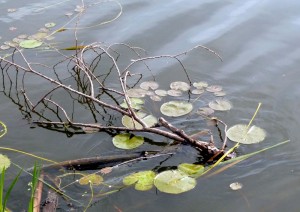A dozen folks enjoyed a close look at Warner Park’s wetland on Sunday June 12, thanks to UW professor Quentin Carpenter, PhD.
Warner’s wetland began life 13,000 years ago under a mile of ice, Carpenter said. The ice sloped down to the vicinity of today’s High Point Road. As the ice sheet melted, a quarter of Dane County was under water, and the Yahara River was in a canyon 250-feet deep. Fine glacial silt settled to the bottom and sealed the soil, preventing water from draining away. One result was a 500-acre wetland, since reduced by development, fill and other manmade and natural changes.
Warner is a designated Wisconsin wetland, though not a great one, Carpenter said. Nonetheless, he was surprised by the wide variety of plant life as he strolled along the lagoon’s edge. The group saw plants ranging from wet prairie plants to the floating sedge meadow reachable only by boat. The sedge meadow creates ideal habitat for birds, a “fiber matte” that can be walked on with caution, and a “peat soup” below.

As he pointed out blue flag iris, mountain mint, spike flower and several sedges, barn swallows ducked under the pedestrian bridge where they have made a home. Along the wetland’s edge, the familiar cattail shares space with bulrush, bur reed, “five-fruited” sedge, jewel weed (good for treating the rash from stinging nettle), poison water hemlock, duck week and “lots and lots” of wetland plants, he said. Many of the plants will bloom into the summer, including tick trefoil.
Warner’s wetland helps account for the 114 species of birds that have been documented in the park. “There is a lot of food here for birds,” Carpenter said. The wetland provides more food for migrating birds that “corporate ponds.” More than 20 species of ducks alone probably use Warner.
The wetland also provides home and food for muskrats, leopard frogs, chorus frogs – and, of course, geese. Because of Warner Park’s vast mowed lawns, the city has created “ideal habitat” for geese, he said. The geese eat grass, and contribute to the eutrophic condition of the water.

Thanks to Marilyn Sallee, a master naturalist, for the photos from the walk. Her photos are here.
You must be logged in to post a comment.